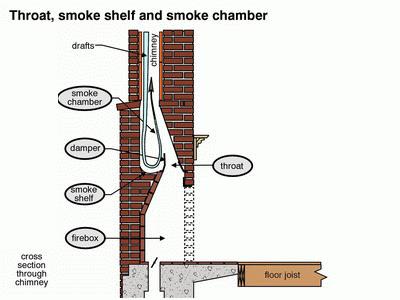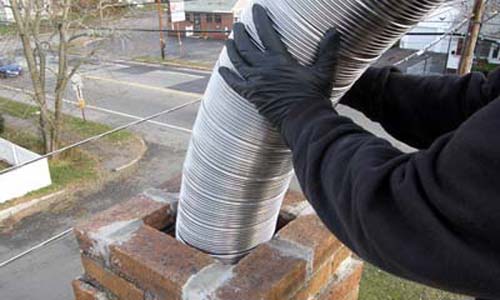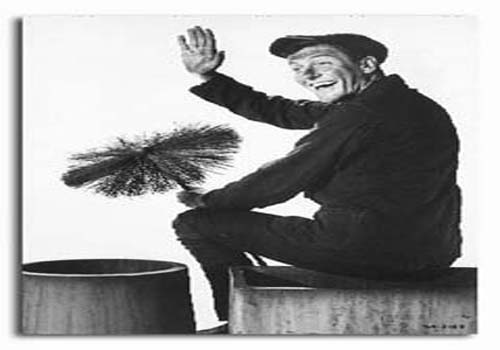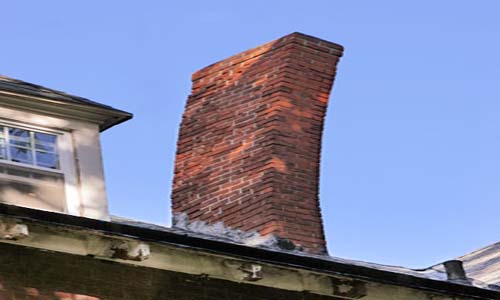How to Clean your Chimney
May 26, 2015 in How to Clean your Chimney

This cross section of a chimney gives you an idea of all the parts that need to be cleaned and free of creosote when a chimney sweep is performed. It is entirely possible to do this project yourself and we provide step by step instructions on how to sweep your chimney below, however, this is one of those around the home jobs that is better left to the professionals. Safety should be your priority and a professional will be able to identify hazards as well as clean your chimney. Please take the following information into account when making the decision to clean your own chimney.
A lot of
customers want to know what the
average cost of getting your
chimney cleaned and inspected
will run. While
every professional is different,
you should expect to pay around
$200-$300 depending on
the area of the US you are
located in, what type of chimney
you have, who you hire to do
your cleaning, how steep your
roof is, and how dirty your
chimney is.
Costs can vary greatly, so
please take this as an average
estimate, not a guarantee.
The cost of the initial
cleaning may be more expensive
than any subsequent cleaning.
Any build-up that has solidified
over the years may be very
difficult to remove and so the
cleaning will need to be more
extensive and this cannot be
determined until after the
professional has come to your
home and inspected your chimney.
Stove
inserts that do not have liners
that run to the top of the
chimney need to be pulled out
for access and run an extra $40-$50.
Compare this to the cost
of the supplies you will need, a
brush and rod set runs about
$30 for a masonry chimney
and will slightly more for a
metal chimney, plus all the
other helpful equipment that you
would need: a shop vacuum,
ladder, stiff scrubbing brush,
safety goggles, dust mask and
drop cloths.
These items all add up but could
potentially pay for themselves
after years of regular
cleanings.
More important than a cost
variance analysis between hiring
a professional and doing it
yourself is SAFETY
for you and your family.
Most
homeowners do not have working
knowledge of their chimney and
venting systems. This situation
is complicated by the fact that
faults, damage and problems are
rarely visible to the casual
observer. In fact, people who
will quickly replace a faulty
automobile exhaust system
because of the hazard it
presents will allow their
chimney or vent to go unchecked
and unmaintained for years.
You should be
cleaning your chimney every 50
to 75 fires or if you do not use
it that often, annually. The
threat of chimney fires and
unsafe indoor air quality
conditions can be greatly
reduced, perhaps even
eliminated, if homeowners
understood that chimneys are
active home operation systems
which require an annual cleaning
and maintenance.
Cleaning
means removing the hazard of
accumulated and highly
combustible creosote produced by
burning wood and wood products.
It means eliminating the
build-up of soot in
coal-and-oil-fired systems, and
it means getting rid of bird and
animal nests, leaves and other
debris that may create a hazard
by blocking the flow of
emissions from a home heating
appliance.
You don’t want any of these
harmful chemicals entering into
your home and the actual
cleaning process is not good for
your lungs.
The health of you and your
family is another factor that
leads a lot of people to
outsource this job to the
professionals who have the
correct safety equipment and
know how to maintain clean air
quality within your home.
Here are
some steps to follow when
performing your annual chimney
cleaning if you wish to do it
yourself.
1. Place a drop
cloth or tarp is in front of
fireplace, with at least a five
foot radius surrounding the
fireplace area to catch any
creosote (aka: soot) that will
disperse into the room.
2.
If there is a
large amount of ash that has
accumulated in your firebox,
scoop it out first.
Also, remove your
fireplace grate, so you can
access your chimney free of
obstructions.
3.
Inspect the
chimney to determine level of
dirtiness and safety.
You can use a flashlight
to look into the chimney but we
recommend that you drop a camera
from the rooftop to get close up
views of the chimney liner,
damper, smoke shelf and firebox
from all sides.
It is important to know
that a chimney deteriorates from
the top downwards, so inspect
from the rooftop and use extra
scrutiny at the top.
4.
Check for any
cracks in the liner, a collapsed
liner, or any other
obstructions.
If you have a properly installed
chimney cap, this should prevent
any obstructions such as an
animal’s nest but you should
check regardless.
If you do happen to have
an animal nesting in your
chimney or a beehive
infestation, please refer to our
how to
remove an obstruction
page.
Debris and feces left
behind from an old inhabitant
will have to be part of your
cleaning process if they happen
to be there.
5.
Scrub the flue,
smoke chamber, smoke shelf, and
damper with a chimney brush to
remove all creosote buildup.
Please refer to our
highly recommended chimney
tools page to help in
choosing the correct equipment
if you do not already have a
chimney brush.
6. After
scrubbing, use a shop-vacuum
(preferably one with a micro
filter to prevent airborne dust)
to vacuum the fallen soot from
your firebox and within your
smoke-chamber and smoke-shelf
areas.
Other
Supplies that come in handy when
cleaning your chimney:
·
Heavy duty Shop
vacuum
·
Ladder – most
work is done on the roof
·
Stiff scrubbing
brush
·
Safety goggles
·
Dust
mask/Respirator
·
Drop cloths –
you do not want ashes getting in
your living space
·
ACS – “Anti
creo soot” creosote removal
spray
·
ChimneyRX –
fireplace crack and joint
sealant
·
ChimneySaver –
Water repellent



